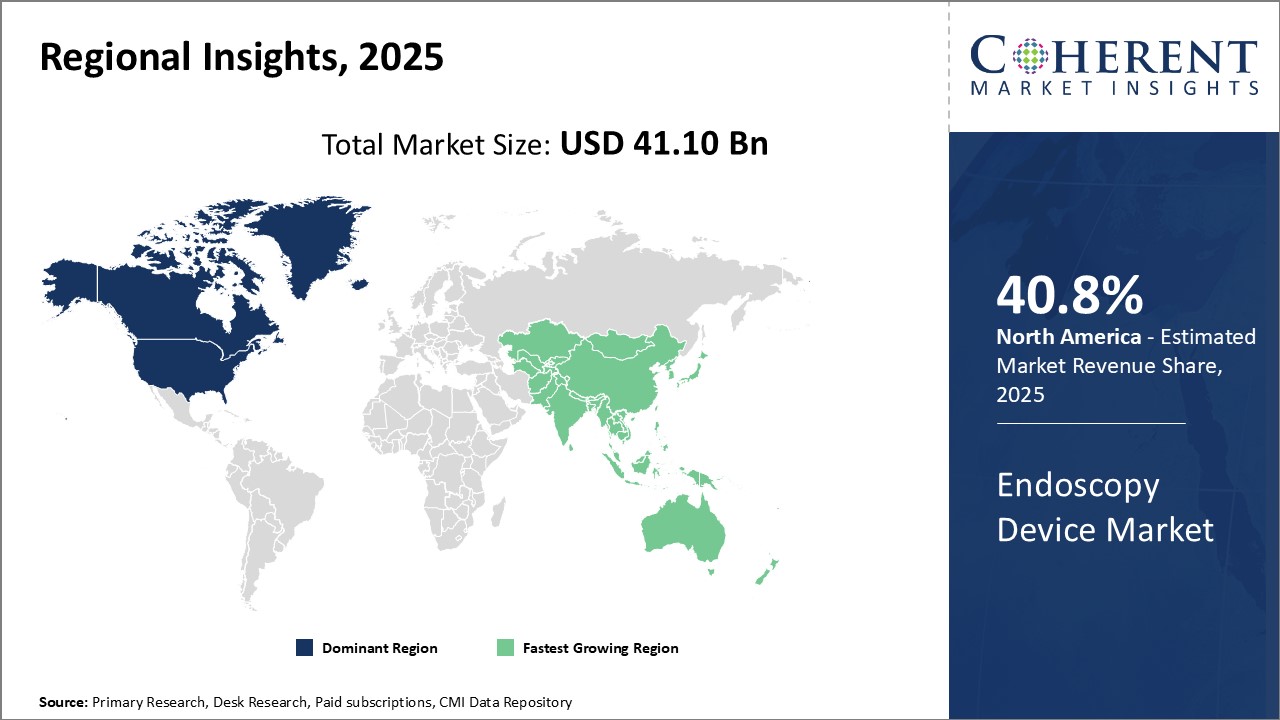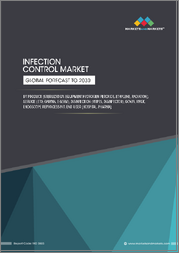
|
시장보고서
상품코드
1672701
내시경 기기 시장 : 제품 유형별, 용도별, 최종 사용자별, 지역별Endoscopy Device Market, By Product Type, By Application, By End User, By Geography |
||||||
세계의 내시경 기기 시장은 2025년에는 411억 달러를 기록할 것으로 추정됩니다. 2032년에는 695억 7,000만 달러에 이를 것으로 예측되며, 2025-2032년까지의 연평균 성장률(CAGR)은 7.8%를 나타낼 것으로 전망됩니다.
| 보고 범위 | 보고서 세부정보 | ||
|---|---|---|---|
| 기준 연도 | 2024년 | 2025년 시장 규모 | 411억 달러 |
| 실적 데이터 | 2020-2024년 | 예측 기간 | 2025-2032년 |
| 예측 기간(2025-2032년) CAGR | 7.80% | 2032년 금액 예측 | 695억 7,000만 달러 |

내시경 기기는 인체 내부의 저침습 의료 검사 및 외과 수술을 실시하기 위한 기기입니다. 일반적인 내시경 기기로는 내시경, 시각화 시스템, 기계식 내시경 기기, 액세서리 등이 있습니다. 내시경 기기의 기술적 진보로 의사는 침습적인 방식으로 질병을 정확하게 진단하고 치료할 수 있습니다. 세계의 암, 소화기질환, 폐질환의 이환율 증가가 내시경검사 수요를 밀어 올리고 있습니다. 게다가 기존의 개복수술보다 낮은 침습수술을 선호하는 경향이 강해지고 있는 것도 내시경기기 시장의 성장을 뒷받침하고 있습니다. 그러나 내시경 기기 및 치료와 관련된 비용이 높기 때문에 개발 도상국에서의 보급이 제한될 수 있습니다.
시장 역학
세계의 내시경 기기 시장은 주로 암이나 기타 대상 질환을 발병하기 쉬운 노인 증가가 견인하고 있습니다. 세계보건기구(WHO)에 따르면 60세 이상의 노인 수는 2050년까지 세계에서 20억 명에 달할 것으로 예상됩니다. 대장암 등 소화기 질환의 부담 증가도 내시경 검사의 필요성을 높이고 있습니다. 그러나 내시경 기기 및 절차와 관련된 높은 비용이 시장 성장을 방해할 수 있습니다. 예를 들어, 간단한 대장 내시경 검사는 선진국에서 약 5,000달러의 비용이 듭니다. 게다가 신흥국이나 저개발 지역에서는 숙련된 내시경의가 적은 것이 시장 성장의 큰 과제가 되고 있습니다. 시장 개척자는 가격에 민감한 신흥국 시장에서 고객 기반을 확대하기 위해 저렴한 가격의 내시경 기기를 개발할 수 있는 좋은 기회를 얻고 있습니다. 로봇 지원 내시경의 채용은 시장에서 인기를 끌고 있는 주요 동향입니다. 로봇 내시경은 의사에게 더 큰 통제, 시각화 및 수술 자율성을 설명합니다. 소형 내시경 기기, 캡슐 내시경, 단회 절개 내시경 수술에 대한 연구가 진행되고 있으며, 시장 진출자에게 기회를 제공할 수 있습니다. 의료 지출을 증가시키기 위한 유리한 정부 시책의 이행은 시장 성장을 가속할 수 있습니다.
이 조사의 주요 특징
본 보고서에서는 세계의 내시경 기기 시장을 상세하게 분석하여 2024년을 기준연도로 한 예측기간(2025-2032년) 시장 규모(10억 달러)와 연간 평균 성장률(CAGR%)을 제공합니다.
또한 다양한 부문에 걸친 잠재적인 수익 기회를 밝히고 이 시장의 매력적인 투자 제안 매트릭스를 설명합니다.
또한 시장 성장 촉진요인, 억제요인, 기회, 신제품의 출시 및 승인, 시장 동향, 지역에 의한 전망, 주요 기업이 채용하는 경쟁 전략 등에 관한 중요한 인사이트도 제공합니다.
기업 하이라이트, 제품 포트폴리오, 주요 하이라이트, 재무 실적, 전략 등의 매개변수를 기반으로 세계의 내시경 기기 시장 주요 기업을 프로파일링합니다.
주요 기업으로는 Olympus, Karl Storz, Stryker, Boston Scientific, Ethicon and Fujifilm 등이 있습니다.
이 보고서의 인사이트를 통해 마케팅 담당자와 기업 경영진은 향후 제품 출시, 타이핑, 시장 확대, 마케팅 전술에 대한 정보를 바탕으로 의사 결정을 내릴 수 있습니다.
세계의 내시경 기기 시장 보고서는 투자자, 공급업체, 제품 제조업체, 유통업체, 신규 참가자, 재무 분석가 등 이 산업의 다양한 이해관계자를 지원합니다.
이해관계자는 세계의 내시경 기기 시장 분석에 사용되는 다양한 전략 매트릭스를 통해 의사 결정을 용이하게 할 수 있습니다.
목차
제1장 조사의 목적과 전제조건
- 조사 목적
- 전제조건
- 약어
제2장 시장 전망
- 보고서 설명
- 시장 정의와 범위
- 주요 요약
제3장 시장 역학, 규제, 동향 분석
- 시장 역학
- 영향 분석
- 규제 시나리오
- 제품 출시/승인
- PEST 분석
- Porter's Five Forces 분석
- 합병과 인수 시나리오
제4장 세계의 내시경 기기 시장, 제품 유형별(2020-2032년), 10억 달러
- 서론
- 경성 내시경
- 연질 내시경
- 내시경 시각화 시스템
- 내시경 액세서리
제5장 세계의 내시경 기기 시장, 용도별(2020-2032년), 10억 달러
- 서론
- 위장 내시경
- 복강경
- 산부인과 내시경
- 관절 내시경
- 비뇨기과 내시경(방광 내시경)
- 기관지 내시경
- ENT 내시경
- 종격동 내시경
- 기타
제6장 세계의 내시경 기기 시장, 최종 사용자별(2020-2032년), 10억 달러
- 서론
- 병원 및 클리닉
- 외래수술센터(ASC)
- 연구 실험실
- 기타
제7장 세계의 내시경 기기 시장, 지역별(2020-2032년), 10억 달러
- 서론
- 북미
- 라틴아메리카
- 유럽
- 아시아태평양
- 중동
- 아프리카
제8장 경쟁 구도
- Olympus Corporation
- Boston Scientific Corporation
- Fujifilm Holdings Corporation
- KARL STORZ SE & Co. KG
- Stryker Corporation
- Medtronic, plc
- Johnson & Johnson
- Smith & Nephew plc
- Richard Wolf GmbH
- Cook Medical
- HOYA Corporation
- Nipro Corporation
- Ambu A/S
- Intuitive Surgical, Inc.
- Braun Melsungen AG
- Teleflex Incorporated
- CapsoVision, Inc.
- Laborie Medical Technologies Inc.
- Dantschke Medizintechnik GMBH & Co. KG
- Fortimedix Surgical BV
제9장 애널리스트 추천
- 융성과 쇠퇴
- 일관형 기회 맵
제10장 참고문헌과 조사 방법
- 참고문헌
- 조사 방법
- 출판사에 대해
Global Endoscopy Device Market is estimated to be valued at USD 41.10 Bn in 2025 and is expected to reach USD 69.57 Bn by 2032, growing at a compound annual growth rate (CAGR) of 7.8% from 2025 to 2032.
| Report Coverage | Report Details | ||
|---|---|---|---|
| Base Year: | 2024 | Market Size in 2025: | USD 41.10 Bn |
| Historical Data for: | 2020 To 2024 | Forecast Period: | 2025 To 2032 |
| Forecast Period 2025 to 2032 CAGR: | 7.80% | 2032 Value Projection: | USD 69.57 Bn |

Endoscopy devices are instruments used to perform minimally invasive medical examinations and surgical procedures of the interior parts of the human body. Some common endoscopy devices include endoscopes, visualization systems, mechanical endoscopy equipment, and accessories. Technological advancements in endoscopy devices have enabled physicians to accurately diagnose and treat diseases in a less invasive manner. Rising incidence of cancer, gastrointestinal and lung diseases worldwide has boosted demand for endoscopy procedures. Moreover, growing preference for minimally invasive surgeries over traditional open surgeries also drives the endoscopy device market growth. However, high costs associated with endoscopic devices and procedures may limit their widespread adoption in developing nations.
Market Dynamics:
Global endoscopy device market growth is primarily driven by rising geriatric population who are more prone to develop cancer and other target diseases. According to the World Health Organization (WHO), the number of people aged 60 years and above is expected to reach 2 billion by 2050 globally. Growing burden of gastrointestinal diseases like colon cancer also boosts the need for endoscopy procedures. However, high costs associated with endoscopy devices and procedures could hamper the market growth. For instance, a simple colonoscopy procedure can cost around US$ 5,000 in developed countries. Moreover, dearth of skilled endoscopists in developing and underdeveloped regions poses a major challenge for market growth. The market players have enormous opportunity to develop low-cost endoscopy devices to expand their customer base in price-sensitive developing markets. Adoption of robot-assisted endoscopy is a key trend gaining popularity in the market. Robotic endoscopy provides greater control, visualization and surgical autonomy to physicians. Ongoing research in miniature endoscopy devices, capsule endoscopes and single-incision endoscopic surgery can offer opportunities for market players. Implementation of favorable government policies to increase healthcare spending can drive the market growth.
Key features of the study:
This report provides in-depth analysis of the global endoscopy device market, and provides market size (USD Billion) and compound annual growth rate (CAGR%) for the forecast period (2025-2032), considering 2024 as the base year
It elucidates potential revenue opportunities across different segments and explains attractive investment proposition matrices for this market
This study also provides key insights about market drivers, restraints, opportunities, new product launches or approval, market trends, regional outlook, and competitive strategies adopted by key players
It profiles key players in the global endoscopy device market based on the following parameters - company highlights, products portfolio, key highlights, financial performance, and strategies
Key companies covered as a part of this study include Olympus, Karl Storz, Stryker, Boston Scientific, Ethicon and Fujifilm
Insights from this report would allow marketers and the management authorities of the companies to make informed decisions regarding their future product launches, type up-gradation, market expansion, and marketing tactics
Global endoscopy device market report caters to various stakeholders in this industry including investors, suppliers, product manufacturers, distributors, new entrants, and financial analysts
Stakeholders would have ease in decision-making through various strategy matrices used in analyzing the global endoscopy device market
Detailed Segmentation-
- By Product Type
- Rigid Endoscopes
- Flexible Endoscopes
- Endoscopic Visualization Systems
- Endoscopic Accessories
- By Application
- Gastrointestinal Endoscopy
- Laparoscopy
- Obstetrics/ Gynecology Endoscopy
- Arthroscopy
- Urology Endoscopy (Cystoscopy)
- Bronchoscopy
- ENT Endoscopy
- Mediastinoscopy
- Other Applications
- By End User
- Hospitals & Clinics
- Ambulatory Surgical Centers
- Research Laboratories
- Others
- By Region
- North America
- Europe
- Asia Pacific
- Latin America
- Middle East & Africa
- Key Players Insights
- Olympus Corporation
- Boston Scientific Corporation
- Fujifilm Holdings Corporation
- KARL STORZ SE & Co. KG
- Stryker Corporation
- Medtronic, plc
- Johnson & Johnson
- Smith & Nephew plc
- Richard Wolf GmbH
- Cook Medical
- HOYA Corporation
- Nipro Corporation
- Ambu A/S
- Intuitive Surgical, Inc.
- Braun Melsungen AG
- Teleflex Incorporated
- CapsoVision, Inc.
- Laborie Medical Technologies Inc.
- Dantschke Medizintechnik GMBH & Co. KG
- Fortimedix Surgical B.V.
Table of Contents
1. Research Objectives and Assumptions
- Research Objectives
- Assumptions
- Abbreviations
2. Market Purview
- Report Description
- Market Definition and Scope
- Executive Summary
- Global Endoscopy Device Market, By Product Type
- Global Endoscopy Device Market, By Application
- Global Endoscopy Device Market, By End User
- Global Endoscopy Device Market, By Region
3. Market Dynamics, Regulations, and Trends Analysis
- Market Dynamics
- Impact Analysis
- Key Highlights
- Regulatory Scenario
- Product Launches/Approvals
- PEST Analysis
- PORTER's Analysis
- Merger and Acquisition Scenario
4. Global Endoscopy Device Market, By Product Type, 2020-2032, (USD Bn)
- Introduction
- Market Share Analysis, 2025 and 2032 (%)
- Y-o-Y Growth Analysis, 2020 - 2032
- Segment Trends
- Rigid Endoscopes
- Introduction
- Market Size and Forecast, and Y-o-Y Growth, 2020-2032, (USD Bn)
- Flexible Endoscopes
- Introduction
- Market Size and Forecast, and Y-o-Y Growth, 2020-2032, (USD Bn)
- Endoscopic Visualization Systems
- Introduction
- Market Size and Forecast, and Y-o-Y Growth, 2020-2032, (USD Bn)
- Endoscopic Accessories
- Introduction
- Market Size and Forecast, and Y-o-Y Growth, 2020-2032, (USD Bn)
5. Global Endoscopy Device Market, By Application, 2020-2032, (USD Bn)
- Introduction
- Market Share Analysis, 2025 and 2032 (%)
- Y-o-Y Growth Analysis, 2020 - 2032
- Segment Trends
- Gastrointestinal Endoscopy
- Introduction
- Market Size and Forecast, and Y-o-Y Growth, 2020-2032, (USD Bn)
- Laparoscopy
- Introduction
- Market Size and Forecast, and Y-o-Y Growth, 2020-2032, (USD Bn)
- Obstetrics/ Gynecology Endoscopy
- Introduction
- Market Size and Forecast, and Y-o-Y Growth, 2020-2032, (USD Bn)
- Arthroscopy
- Introduction
- Market Size and Forecast, and Y-o-Y Growth, 2020-2032, (USD Bn)
- Urology Endoscopy (Cystoscopy)
- Introduction
- Market Size and Forecast, and Y-o-Y Growth, 2020-2032, (USD Bn)
- Bronchoscopy
- Introduction
- Market Size and Forecast, and Y-o-Y Growth, 2020-2032, (USD Bn)
- ENT Endoscopy
- Introduction
- Market Size and Forecast, and Y-o-Y Growth, 2020-2032, (USD Bn)
- Mediastinoscopy
- Introduction
- Market Size and Forecast, and Y-o-Y Growth, 2020-2032, (USD Bn)
- Other Applications
- Introduction
- Market Size and Forecast, and Y-o-Y Growth, 2020-2032, (USD Bn)
6. Global Endoscopy Device Market, By End User, 2020-2032, (USD Bn)
- Introduction
- Market Share Analysis, 2025 and 2032 (%)
- Y-o-Y Growth Analysis, 2020 - 2032
- Segment Trends
- Hospitals & Clinics
- Introduction
- Market Size and Forecast, and Y-o-Y Growth, 2020-2032, (USD Bn)
- Ambulatory Surgical Centers
- Introduction
- Market Size and Forecast, and Y-o-Y Growth, 2020-2032, (USD Bn)
- Research Laboratories
- Introduction
- Market Size and Forecast, and Y-o-Y Growth, 2020-2032, (USD Bn)
- Others
- Introduction
- Market Size and Forecast, and Y-o-Y Growth, 2020-2032, (USD Bn)
7. Global Endoscopy Device Market, By Region, 2020 - 2032, (USD Bn)
- Introduction
- Market Share (%) Analysis, 2025,2028 & 2032, Value (USD Bn)
- Market Y-o-Y Growth Analysis (%), 2020 - 2032, Value (USD Bn)
- Regional Trends
- North America
- Introduction
- U.S.
- Canada
- Latin America
- Introduction
- Brazil
- Argentina
- Mexico
- Rest of Latin America
- Europe
- Introduction
- Germany
- U.K.
- Spain
- France
- Italy
- Russia
- Rest of Europe
- Asia Pacific
- Introduction
- China
- India
- Japan
- Australia
- South Korea
- ASEAN
- Rest of Asia Pacific
- Middle East
- Introduction
- GCC Countries
- Israel
- Rest of Middle East
- Africa
- Introduction
- South Africa
- North Africa
- Central Africa
8. Competitive Landscape
- Olympus Corporation
- Company Highlights
- Product Portfolio
- Key Developments
- Financial Performance
- Strategies
- Boston Scientific Corporation
- Company Highlights
- Product Portfolio
- Key Developments
- Financial Performance
- Strategies
- Fujifilm Holdings Corporation
- Company Highlights
- Product Portfolio
- Key Developments
- Financial Performance
- Strategies
- KARL STORZ SE & Co. KG
- Company Highlights
- Product Portfolio
- Key Developments
- Financial Performance
- Strategies
- Stryker Corporation
- Company Highlights
- Product Portfolio
- Key Developments
- Financial Performance
- Strategies
- Medtronic, plc
- Company Highlights
- Product Portfolio
- Key Developments
- Financial Performance
- Strategies
- Johnson & Johnson
- Company Highlights
- Product Portfolio
- Key Developments
- Financial Performance
- Strategies
- Smith & Nephew plc
- Company Highlights
- Product Portfolio
- Key Developments
- Financial Performance
- Strategies
- Richard Wolf GmbH
- Company Highlights
- Product Portfolio
- Key Developments
- Financial Performance
- Strategies
- Cook Medical
- Company Highlights
- Product Portfolio
- Key Developments
- Financial Performance
- Strategies
- HOYA Corporation
- Company Highlights
- Product Portfolio
- Key Developments
- Financial Performance
- Strategies
- Nipro Corporation
- Company Highlights
- Product Portfolio
- Key Developments
- Financial Performance
- Strategies
- Ambu A/S
- Intuitive Surgical, Inc.
- Braun Melsungen AG
- Teleflex Incorporated
- CapsoVision, Inc.
- Laborie Medical Technologies Inc.
- Dantschke Medizintechnik GMBH & Co. KG
- Fortimedix Surgical B.V.
9. Analyst Recommendations
- Wheel of Fortune
- Analyst View
- Coherent Opportunity Map
10. References and Research Methodology
- References
- Research Methodology
- About us



















